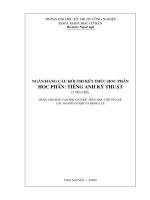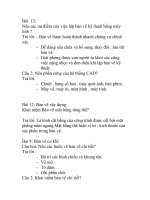ngan hang cau hoi
Bạn đang xem bản rút gọn của tài liệu. Xem và tải ngay bản đầy đủ của tài liệu tại đây (151.54 KB, 9 trang )
Trờng đại học kỹ thuật công nghiệp
Khoa khoa học cơ bản
Bộ môn: Ngoại ngữ
ngân hàng câu hỏi thi kết thúc học phần
học phần: tiếng anh kỹ thuật
(3 tín chỉ)
Dùng cho đào tạo bậc đại học theo học chế tín chỉ
các ngành cơ khí và động lực
Thái nguyên 8/2007
1. NỘI DUNG ĐÁNH GIÁ THI KẾT THÚC HỌC PHẦN
UNIT 1: Engineering – what’s it all about?
Reading: Introduction
Language study: deals with/ is concerned with
Word study; Word stress
Writing: Gap fiiling
UNIT 2: Engineering materials
Reading: Scanning tables
Language study: Making definitions
Writing: Adding information to text
UNIT 3: Mechanisms
Reading: Scanning a text
Writing: Ways of linking ideas 1
Language study: Dealing with technical terms
Speaking practice
UNIT 4: Forces in engineering
Reading 1: Predicting
Reading 2: Grammar links in text
Language study: the Present passive
UNIT 5: Portable generator
Reading: Reading diagrams
Language study: Cause and effect 2
Word study:Verbs with –ize/ise
Writing: Writing process 3, Sequence and location
UNIT 6: Disc brake
Reading: Combining skills
Language study: Verbs with up and down
Word study: Verbs +- en
Writing: Explaining an operation
Technical reading: Water-based hydraulics
UNIT 7: Corrosion
Reading: Skimming
Language study: Cause and effect 3
Speaking practice: Exchanging information
Technical reading: Corrosion of materials
UNIT 8: Graphs
Language study: Describing graphs
Word study: Common verbs in engineering
Writing: Describing graphs (task 6 & 7)
Technical reading: Properties and applications of carbon steels
UNIT 9: Robotics
Reading: Transferring information
Language study: Concession even if and although.
Technical reading: Stepper motors
UNIT 10: Applying for a job
Reading: Understanding job advertisements
Speaking: Role play
Writing: Writing a CV and letter of application
Technical reading: Company structures
2. PHƯƠNG PHÁP ĐÁNH GIÁ
- Tự luận
- Hình thức thi viết (thời gian:90’)
3. NGUYÊN TẮC TỔ HỢP CÂU HỎI ĐỂ LÀM ĐỀ THI KẾT THÚC HỌC PHẦN
- Nguyên tắc:
+ Kết hợp giữa các phần câu hỏi
+ Một đề thi bao gồm 4 loại câu hỏi: 6 câu loại 1, 10 câu loại 2, 5 câu loại 3,
4 câu loại 4
+ Câu hỏi loại 3 được tổ hợp từ các loại 3a, 3b, 3c, 3d, 3e; mỗi loại 1 câu.
- Thang điểm: Điểm toàn bài: 10 điểm
+ Câu hỏi loại 1: 3 điểm (6 câu hỏi đọc hiểu, mỗi câu 0,5điểm)
+ Câu hỏi loại 2: 3 điểm, mỗi câu: 0,25 điểm
+ Câu hỏi loại 3: 2 điểm, mỗi câu: 0,5 điểm
+ Câu hỏi loại 4: 2 điểm, mỗi câu: 0,5 điểm
- Loại câu hỏi:
o Câu hỏi loại 1: Read the following passage and answer the questions below.
o Câu hỏi loại 2: Choose the best word to fill in the gaps.
o Câu hỏi loại 3: Rewrite the following sentences without changing the meanings.
o Câu hỏi loại 4: Give the correct form of the word in brackets.
4. NGÂN HÀNG CÂU HỎI
4.1.Câu hỏi loại 1
1. The four- stroke cycle
Induction stroke with the inlet valve open and the exhaust valve shut, the piston
moves down the cylinder create a partial vacuum. This partial vacuum draws in the atomized
fuel from the carburettor into the cylinder.
Compression stroke with both the inlet and exhaust valve closed, the piston moves up
the cylinder, compressing the fuel mixture. Just before the end of the stroke, an electric spark
across the points of the sparking plug ignites the petrol and air mixture.
Power stroke Both valves remain closed. During the tiny interval of time required for
flame to establish itself, the piston has reached its highest position in the cylinder. The gas
generated by the burning fuel now expands rapidly, driving the piston down the cylinder.
This downward push is converted into a rotary movement by the connecting rod and
crankshaft. A water jacket contained within the cylinder walls helps to conduct away the heat
generated during this burning and thus keeps the engine cool.
Exhaust stroke The exhaust valve opens but the inlet valve remains shut. The piston
moves up the cylinder, pushing the exhaust gas out through the exhaust valve. With the
completion of the exhaust stroke the cycle begins again.
Questions:
1. Say which word in the text has the same meaning as “a flash of light”
2. Find in the text which word means “produced”
3. In the text which word has the same meaning as “closed”
4. In power stroke what causes the piston to move down the cylinder?
5. There are three differences between Induction and Exhaust stroke. What are they?
6. In compression stroke when does the ignition start?
2. Consumption of energy resources, (e.g. turning on a light) is apparently harmless.
However, producing that energy requires resources and contributes to air and water
pollution. Many electric power plants burn coal oil or natural gas in order to generate
electricity for energy needs. While burning these fossil fuels produces a readily available and
instantaneous supply of electricity, it also generates air pollutants including carbon dioxide
(CO2), sulfur dioxide and trioxide (SOx) and nitrogen oxides (NOx). Carbon dioxide is an
important greenhouse gas which is thought to be responsible for some fraction of the rapid
increase in global warming.
Burning fossil fuels for electricity generation also releases trace metals such as beryllium,
cadmium, chromium, copper, manganese, mercury, nickel, and silver into the environment,
which also act as pollutants. Certain renewable energy technologies do not pollute the
environment in the same ways, and therefore can help contribute to a cleaner energy future
for the world. Renewable energy technologies available for electricity production include
biofuels, solar power, tidal power, wind turbines, hydroelectric power, etc. However, serious
environmental concerns have been articulated by several environmental activists regarding
these modes of electricity generation. According to them, some pollution is invariably
produced during the manufacture and retirement of the materials associated with the
machinery used in these technologies. A central way to avoid downsides of expanding
energy production is energy conservation.
Questions:
1.Does consumption of energy make the air and water polluted?
2.To generate electricity what are burned by many electric power plants?
3. What air pollutant generated while burning fossil fuels has a great contribution to
global warming?
4.What trace metals that pollute the environment are released while burning fossil fuels?
5.What do renewable energy technologies consist of?
6.What are the disadvantages of using renewable energy technologies?
3. Jet engines
The three most common types of jet engines are the turbojet, turboprop, and turbofan.
Air entering a turbojet engine is compressed and passed into a combustion chamber to be
oxidized. Energy produced by the burning fuel spins the turbine that drives the compressor,
creating an effective power cycle. Turboprop engines are driven almost entirely by a
propeller mounted in the front of the engine, deriving only 10% of their thrust from the
exhaust jet. Turbofans combine the hot air jet with bypassed air from a fan, also driven by
the turbine. The use of bypass air creates a quieter engine with greater boost at low speeds,
making it a popular choice for commercial airplanes.
The turbine or jet engine operates on the principle of Newton’s third law of motion,
which states that for every action, there is an opposite but equal reaction. A jet sucks air into
the front, squeezes the air by pulling it through a series of spinning compressors, mixes it
with fuel and ignites the mixture, which then explodes with great force rearward through the
exhaust nozzle. The rearward force is balanced with an equal force that pushes forward the
jet engine and the airplane attached to it. A rocket engine operates in the same principle
except that, in order to operate in the airless vacuum of space, the rocket must carry along
with its own air, in the front of solid propellant or liquid oxidizer for combustion.
Questions:
1. What does “it” (paragragh 1) refer to ?
2. What happens to the air after it enters the turbojet engine?
3. What does “which” (paragragh 2, line 1) refer to ?
4. What word in paragragh 1 has the same meaning as “completely”?
5. How is a rocket engine different from a jet engine?
6. What then explodes with great force rearward through the exhaust nozzle?
4. Today engines can produce enough power to lift the heaviest weights and drive the
largest machines. The most powerful engine is the rocket engine, it can blast a spacecraft
away from the pull of the Earth's gravity and out into space.
The engine that powers almost the world's cars is the internal-combustion engine. It uses
the power of gases created by exploding fuel to produce movement. A mixture of air and tiny
droplets of gasoline enters the engine's cylinders, each of which contains a piston. An
electrical spark ignites the fuel mixture, producing gases which thrust each piston down.
Many trains and trucks have been powered by diesel engine, which are internal-
combustion engines that burn diesel fuel instead of gasoline. The engine works in the same
way as a gasoline-fueled engine, but does not have spark plugs. Instead, each cylinder has an
injector that squirts diesel fuel into the cylinder. The piston compresses the air, making it
very hot. The hot air makes the diesel fuel explode.
If we use only gasoline and diesel engines today, there would be many problems with
the environment. These kinds of engines produce waste gases that pollute the air and
contribute to the greenhouse effect which causes the Earth's temperature to rise. Fortunately,
electric motors, which are clean, quiet, and produce no pollution, have been used as an
alternative. In fact, several car manufacturers are developing cars powered by electric
motors. However, most electric cars are still experimental. If efficient batteries are
successfully developed, electric cars will be an ideal solution for transportation.
Questions:
1. Which engine is the most powerful?
2. What kind of engine powers almost all the world's cars?
3. Do diesel engines have spark plugs?
4. How does the diesel engine operate?
5. What happens if we use diesel engines today ?
6. What do several car manufacturers are doing?
5.
1. The mechanical valve is one of the oldest pieces of technology known to mankind. If
we define a valve as a device to regulate a flow, then the earliest recorded use of a valve was
by Egyptian farmers in pre-Pyramid days to control the flow of Nile flood water in specially
dug irrigation channels. The earliest valve was a simple piece of wood slotted down into a
stream. Despite the engineering skills of the Romans, a similar device was still being used
two thousand years later by Lancashire to cut off the mill stream or raceway, when repairs to
the wheel were called for.
2. Whatever was happening on the open stream, it was within pipes that valves were
developing. The Romans had piped water coming in from nearby stream to water towers









